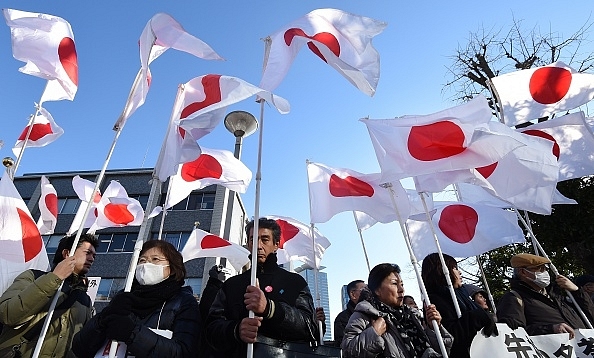
Why Japan Has Been Stagnant For 30 Years: Answers Are in Religion And Culture
- After achieving miraculous growth rates since World War II, the Japanese economy slowed down from 1990 onwards unlike the US economy
- Economists have tried everything possible measure in the rule book or even ones outside it to make the economy grow but to no avail
- The reason may actually lie in what the economists tend to ignore: culture, religion and belief in god - how it propels
demography and growth.
Japan was one of the great powers of 20thcentury.
It rose and fell, only to rise again– all within 100 years. The second riseis particularly notable: from 1955 to 1990 its nominal GDP grew from 8.4 trillion yen to around 430 trillion yen or about 12 percent per annum. Underlying factors behind the economicmiracle are well documented. From 1990till 2015, however, the nominal GDP has grown only to 499 trillion yen or at dismal0.6 percent per annum.
Radical monetary policies, liberal fiscalpolicies, speeches, criticisms, taunting – nothing seems to work. While the third arrow of PM Shinzo Abe, the “structuralreforms” is still due, one is not convinced that this will make a lasting impact oneconomic growth. None of the commentators who talk genericallyof “structural reform” (not just for Japan, but elsewhere too) quantify adequately thehigher economic growth that the reforms are supposed to result in.
How can a country lose its mojo so quickly?Have the Japanese people suddenly become less creative, less intelligent, less motivated and less hard working? Or is there somethingelse that is responsible?
The answer may lie in an altogether different matrix. During the boom years of1955-1990, Japan’s population grew from 89 million to 124 million or around0.93 percent per annum. In 1990-2015 period,however, population grew at a dismal 0.1 percent per annum. Did the Japanese suddenly stop havingchildren in 1990? The data shows it was quiteliterally so. In each of the decades starting 1950 till 1990 the population grewat just over 1 percent per annum and then in the decade of 1990-2000, it dropped to0.26 percent per annum.
The reason why counting the population datais important is because there are strong sociological reasons underlying the plight ofJapan’s economy. I hope socialresearchers will devote more time to study the linkage between a secularised society andeconomic growth.
What did the Japanese children born from1950 to 1980 see growing up? Their fathers spent 15 hours at work while children faced intense competition for a placein school or a college, and eventually in jobs. They saw dramatic wealthincrease but also felt what it takes to generate such wealth. Inherent in this isan unrealistic expectation of the society and parents that all children oughtto achieve academic and economic success. Add to this insecurity over the endurance of the hard earned prosperitygiven the recent experience of total destruction in the world war.
But not all rich countries have decliningpopulations. Look at the US or the Middle East, where population has continuedto grow. In fact, Europe and Japanprovide more government support for families and children than the US. Yet the reluctance to have children in Japan is intriguing.
The answer has to be in religion. The US and the Middle East are considerablymore religious compared to the rich countries of Europe and Japan. Europe clearly is very much secular. Japanese society is still very traditional onthe surface and follows traditions without conviction. Itappears as though the society collectively has asked itself what is the point ofit and has decided to slowly fade – a natural collective hara kiri. Somewhere down the line is going to be thisbeautiful piece of land with skyscrapers and bullet trains, gardens and hotsprings, but that’s it and nothing else – the feeling of emptiness.
Let us look at data in the US. The US economy grew from $437 billion in1955 to $6 trillion in 1990 (7.7 percent per annum for 35 years) and then to $18trillion by 2015 (4.5 percent per annum for 25 years). Through this and unlike in Japan, the population grew from 166 millionin 1955 to 250 million in 1990 (1.2 percent per annum for 35 years), and again to 321 million in2015 (1.0 percent per annum for 25 years). Notmuch of a drop.
As Warren Buffet breaksdown in the 2015 letter to shareholders though not linking it as a cause foreconomic growth, population growth in the US is currently around 0.8 percent, withimmigration contributing 0.3 percent.
Japan has more or less shut doors on the immigration. The government is trying toget more women into the labour force, force wage increases and other means whilethe central bank is trying negative interest rates after many years ofquantitative easing that yielded little. Probably, Prime Minister Abe will get better results by speaking to thereligious leaders and begin a slow process of the society believing in a“greater purpose” of individual lives enriching the society with life and framedin the context of its own religious traditions. Who would have thought that increased religiosity can actually benefitthe economy.
It is often said in the long runproductivity is everything. That may betrue, but it does not seem to be a sufficient condition. A second axiom that demography is destiny isalso true - in the case of today’s Japan probably even more so.
References: Data has been sourced from
1. US Census Bureau
2. St. Louis Fed